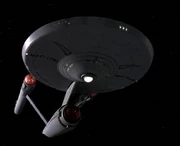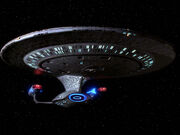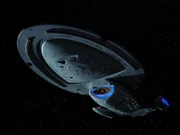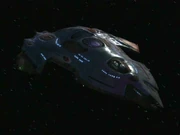Starfleet (also referred to as the Federation Starfleet after 2161) was the military and deep-space exploratory service maintained by the United Federation of Planets. Described as a "peacekeeping and humanitarian armada" by an alternate reality Christopher Pike, its principle functions were the advancement of Federation knowledge about the galaxy and its inhabitants, the advancement of Federation knowledge of science and technology, and the military defense of the Federation. It also played a significant diplomatic role.
As per its mandate of deep-space exploration, its personnel were frequently brought into contact with cultures and sentient species whose existences were unknown to the Federation. Federation Starfleet officers therefore acted as official representatives of the Federation in these cases. Also, Federation Starfleet vessels were frequently used to ferry ambassadors on diplomatic missions. (TNG: "The Last Outpost"; VOY: "Innocence", "The Void"; TOS: "Journey to Babel")
History
Pre-Federation
Prior to 2161, Starfleet was the primary space defense and exploration organization of United Earth in the early-to-mid-22nd century. The primary authority of Starfleet was referred to as either Starfleet Command or UESPA (United Earth Space Probe Agency) under the jurisdiction of the Command Council, and was located in the city of San Francisco, Earth. (ENT: "Broken Bow", "Terra Prime")
- Starfleet must have been founded sometime during the 2120s or 2130s, as Jonathan Archer gave some thought to join the Earth Cargo Service a few years before Starfleet was chartered. However, in 2136, Margaret Mullin turns down Archer's proposal of marriage, since she does not want to become a "Starfleet widow", which seems to indicate that Starfleet was operational by then. (ENT: "Horizon", "Twilight")
The primary purpose of Starfleet from its infancy was to "...seek out new life and new civilizations." and "...go boldly where no man has gone before." (This quote is attributed to Zefram Cochrane, the inventor of warp drive on Earth.) (ENT: "Broken Bow")
Some Starfleet personnel worked for the United Earth Diplomatic Corps. This may or may not be a Starfleet department, as the officers could be working for a civilian organization in the interests of galactic politics (ENT: "The Forge").
In 2153, following the Xindi attack on Earth and the numerous firefights that the Enterprise NX-01 had been involved in since its launch in 2151, it was determined that vessels of Starfleet would begin to carry detachments of United Earth's elite military unit, the MACOs, thus taking a step towards the unification of the Earth Starfleet and the Earth military – and of the roles of defense and exploration. (ENT: "The Expanse")
One of the primary projects of the Earth Starfleet was to develop a viable and fast interstellar engine that would allow Earth to practically cross vast distances in reasonably short time. Despite some allegations of interference – or at least, a refusal of assistance – from the Vulcans, Earth had made notable progress in developing the warp five engine by the 2150s. (ENT: "Broken Bow")
Key officials overseeing early Starfleet included:
- Admiral Maxwell Forrest
- Admiral Daniel Leonard
- Admiral Gardner
- Commander Williams
- Forrest, Leonard and Williams were named after William Shatner, Leonard Nimoy and DeForest Kelley.
The Starfleet Charter, Article 14, Section 31, made allowances for certain rules to be bent during times of extraordinary threat. This clause was the seed for the rogue organization known as Section 31. Lieutenant Malcolm Reed was recruited to Section 31 as a young ensign. (ENT: "Affliction", "Divergence")
- In DS9: "Tacking Into the Wind", Julian Bashir said that Section 31 had managed to stay hidden for "over three hundred years". Therefore, the Earth Starfleet should have been chartered before 2075. This however is contradicted by Captain Archer stating that he considered becoming a member of the Earth Cargo Authority "before Starfleet was chartered" in ENT: "Horizon".
- The Latin phrase on the pre-Federation Starfleet seal is "Ad Astra Per Aspera" (which translates roughly as "to the stars through hardships"). It is a modified version of the NASA motto "Per Aspera Ad Astra" ("through hardships to the stars"). It is also the current-day state motto of Kansas. It may also be related to the RAF motto "'Per Ardua Ad Astra'" ("through adversity to the stars").
Federation Starfleet
With the formation of the Federation in 2161, as per the Federation Charter, Starfleet and the deep-space exploratory and military services of the other member worlds were combined to form the Federation Starfleet. (DS9: "Inquisition"; ENT: "Detained", "Divergence").
Until as late as the 2290s, Federation Starfleet operations continued to fall at least partly under the jurisdiction UESPA. By the mid-24th century, however, Federation Starfleet operations were regulated solely by Starfleet Command, answering to the Federation President and the Federation Council. (TOS: "Charlie X", "Tomorrow is Yesterday"; Star Trek IV: The Voyage Home; et al.)
- UESPA was mentioned early in the Original Series before producers finally settled upon "Starfleet". Its inclusion in background details throughout Star Trek: Enterprise, however, indicate that it was far more than a misnomer, but a major operation spanning from the time before the Federation, well into the 23rd century, as indicated by the dedication plaque of the USS Enterprise-B in Star Trek Generations. It was never mentioned in Star Trek: The Next Generation, possibly an indication of its dismantling.
- As it was portrayed working in conjunction with the Earth Starfleet, it seems likely that UESPA worked together with the Federation Starfleet as well, rather than as separate operating authorities.
- It is unclear why the fledgling Federation would utilize so many of Earth's space agencies as major contributors to its own Starfleet, especially considering both Vulcan's and Andoria's superior military and exploratory operations. One theory is paranoia. By placing the fledgling Starfleet in the hands of what was arguably the technologically and militarily weakest species, a balance remained amongst the remaining three powers with none of the four having a significant advantage over the other three.
- Another might be that, early on, planetary authorities operated inside of, yet simultaneously independent of Starfleet as is the case with the relationship between the European Space Agency and its national members. Even though less technologically advanced than other members, United Earth was nonetheless a major player in the Federation (for example, acting as its capital) and no doubt had much influence, for example the construction of Federation ships in the Sol system would have probably used UESPA and Starfleet facilities at first which gave it an advantage.
Organization
Direct commanding authority over the Federation Starfleet was a power of the Federation President. In addition, the Federation Council, the Federation's legislature, often directly influenced the service's operations. (TNG: "Force of Nature"). The day to day operations of the service were managed by Starfleet Command, under a Commander in Chief.
Commander in Chief
The Commander in Chief oversaw the operations of the entire service, and reported directly to the Federation President. (Star Trek VI: The Undiscovered Country).
Starfleet Command
This was the service's operational authority. Senior positions included the Commander, Starfleet. the Chief of Staff and the Chief of Starfleet Operations. (Star Trek III: The Search for Spock; Star Trek IV: The Voyage Home; Star Trek V: The Final Frontier)
- It is unclear precisely what exact functions these positions involved. Nor is it known precisely how they related to each other in terms of command authority.
Sector Commands
These oversaw operations of the service within sectors of Federation space. There were at least 23 sector commands. Sector Commanders reported to Starfleet Command, and commanding officers of service vessels operating within these sectors reported to them. (TNG: "Power Play", "The Measure Of A Man")
Starfleet Academy
- Main article: Starfleet Academy

Starfleet Academy seal
This was a facility maintained by the service for the training of its officers. Prospective officers received extensive training at this facility for a period of four years. Undergraduates attending the facility were called midshipmen in the 23rd century and cadets in the 24th century. Successful graduates were commissioned as Federation Starfleet officers.
Branches and agencies
There were a number of branches and agencies that assisted Starfleet Command in the running of the service.
- Judge Advocate General
- Office of the Inspector General
- Spaceframe development
- Starfleet Administration
- Starfleet Advanced Technologies
- Starfleet Bureau of Information
- Starfleet Corps of Engineers
- Starfleet Exploratory Division
- Starfleet Intelligence
- Starfleet Materiel Supply Command
- Starfleet Medical
- Starfleet Mission Operations
- Starfleet Operational Support Services
- Starfleet Operations
- Starfleet Orbital Operations
- Starfleet Research and Development
- Starfleet Shipyards Operations
- Starfleet Security
- Starfleet Science
- Starfleet Stellar Imaging
- Starfleet Tactical
Personnel
As a military service, Federation Starfleet personnel were organized using a military rank structure into a chain of command. Personnel were in either of two groups: enlisted personnel and officers.
Officers
In the 22nd century, Starfleet was a civilian organization which adopted many aspects of Earth's earlier military forces, even though its main role was scientific development and exploration. Ranks within Starfleet closely follow the traditions of the United States Navy and the British Royal Navy.
Starfleet officers functioned as commanders and directors of the service’s operations at all levels. The most senior officers ranks were known as Flag officer ranks. Officers holding these ranks functioned at the highest levels of command in the service. Flag officer ranks, in descending order of the chain of command, are as follows:
- Fleet Admiral
- Admiral
- Vice Admiral
- Rear Admiral
- Commodore/Rear Admiral, lower half
Sector commanders, the Superintendent of Starfleet Academy, the Commander, Starfleet, the Starfleet Chief of Staff and Chief of Starfleet Operations, and the Commander in Chief, were all flag officers. (Star Trek III: The Search for Spock; TNG: "Ménage à Troi", "The First Duty")
Below flag officer ranks were other officer ranks. Officers holding these ranks usually served in field command positions, such as commanding officers and senior staff on the service’s vessels. These ranks, in descending order of the chain of command, were as follows:
Graduates of Starfleet Academy were commissioned to the rank of ensign, the most junior officer’s rank, and were promoted to higher ranks over the courses of their time in the service. Physicians who graduated from Starfleet Medical Academy were commissioned to the rank of lieutenant junior grade.
Enlisted Personnel
These personnel functioned under the command of the officers, usually serving aboard Federation Starfleet vessels or other facilities. Instead of officers’ training, enlisted personnel received basic training for whatever position they served in. (VOY: "Good Shepherd", et al.) The most junior enlisted rank was that of crewman. The service’s enlisted rank structure, in descending order of the chain of command, was as follows:
The enlisted ranks above that of crewman were not commissioned officer ranks. To distinguish them from commissioned officer ranks, the term 'non-commissioned officer' was used. All enlisted personnel were subordinate to commissioned officers in the chain of command.
Uniforms
In the 22nd century, the same basic uniform was worn by all Starfleet officers, with differences in insignia and color-coded elements designed to distinguish rank and departmental function. Earth Starfleet departments included Starfleet Operations and Starfleet Security. (ENT: "Broken Bow")
Federation Starfleet personnel wore distinctive uniforms while on duty. These uniforms generally displayed the department color of the department/divison the enlisted person or officer served in, and also the rank insignia.
Wearing a Stafleet uniform when not actually a member of Starfleet would put one at risk of being charged with impersonating a Starfleet officer. (DS9: "Chrysalis")
Bases and installations
Aside from its headquarters, located on Earth, the Federation's capital world, the Federation Starfleet also maintained installations throughout Federation territory.
Starbases
Starbase 375
Starbases, facilities for resupply of the service's vessels and the relaxation of vessel crews, were maintained in all sectors of Federation space. In addition, the service also maintained facilities beyond Federation territory. The most well-known of these is Deep Space 9, in the Alpha Quadrant. (Star Trek: Deep Space Nine)
Shipyards
The Utopia Planitia Fleet Yards
The service also maintained a number of shipyards at which it constructed its vessels and designed and tested new vessels and vessel types. Among the most famous of these shipyards were:
- The Utopia Planitia Fleet Yards, located in orbit around Mars
- The San Francisco Fleet Yards, located in orbit around Earth
- The Beta Antares Ship Yards, located in the Antares sector
(TNG: "Parallels", "Eye of the Beholder", "Night Terrors", "The Wounded"; Star Trek: The Motion Picture; VOY: "Message in a Bottle")
Training facilities
Apart from Starfleet Academy, the service also maintained several training facilities for both officers and enlisted personnel. These included a number of Academy annexes, located in different systems. Known annexes were Starfleet Academy (Beta Aquilae II), Starfleet Academy (Beta Ursae Minor II) and Starfleet Academy (Psi Upsilon III). (TNG: "Eye of the Beholder") The service also maintained at least one testing facility to evaluate prospective Starfleet Academy undergraduates for admission into the academy.This facility was located on the planet Relva VII. (TNG: "Coming of Age")
Starfleet academy also had a training program for enlisted personnel. (TNG: "The Drumhead") In addition at least one other such facility was located on Mars, known as the Starfleet Technical Services Academy. (TNG: "Eye of the Beholder")
Vessels
The single most important asset that the Federation Starfleet possessed, apart from its personnel, was its vessels.
Starships
The backbone of Starfleet's operations were its starships. These vessels, all warp-capable, were capable of supporting and providing the ability and resources to carry out all of the service’s mandates: exploration, the military defense of the Federation, the transport of supplies and resources, and providing emergency medical care. A large range of starship classes existed. Some were multi-purpose and other were designed for a specific use.
The most famous ship of pre-Federation Starfleet was the NX class Enterprise NX-01. That ship was the first to be equipped with the Warp 5 engine, and made first contact with over thirty species. Under the command of Captain Jonathan Archer, Enterprise established Earth as an interstellar power after negotiating treaties between the Vulcans and Andorians in 2152, saving the galaxy from the Sphere Builders and the Xindi in 2154, uncovering the lost teachings of Surak on Vulcan and preventing a Vulcan invasion of Andor later in 2154, helping to instigate a cultural and political coup d'etat against the dictatorial Vulcan head of state Administrator V'Las, and attempting to facilitate peace talks between the Andorians and Tellarites following a series of attacks on both races in late 2154. (ENT: "Broken Bow", "Cease Fire", "Zero Hour", "The Forge", "Awakening", and more)
The pre-Federation Starfleet also built the NX-class Columbia NX-02, launching that ship in late 2154. (ENT: "Home", "Affliction")
- It can be assumed that both ships, as well as many other Earth Starfleet vessels, were among the primary line of defense against the Romulans during the Earth-Romulan War of the late 2150s.
Pre-Federation Starfleet did not have any jurisdiction over what happens aboard vessels operating in the Earth Cargo Service. That responsibility remained in the hands of the Earth Cargo Authority. (ENT: "Fortunate Son", "Horizon")

Constitution-class
The Template:ShipClass was historically one of the service’s most important starship classes. Starships of this class were the service’s frontline vessels in the 23rd century, designed for long-term exploratory missions lasting five Earth years. The most recognized of these vessels was the USS Enterprise under the command of Captain James Tiberius Kirk. (Star Trek: The Original Series); Star Trek: The Motion Picture)
The Template:ShipClass was initially constructed during the early 2280s at Starfleet's San Francisco Fleet Yards orbiting Earth. (Star Trek VI: The Undiscovered Country dedication plaque) Starfleet had high hopes for the first ship of this class, the prototype USS Excelsior, which was equipped with transwarp drive, and was regarded as that century's "Great Experiment." (Star Trek III: The Search for Spock) Despite the failure of the "Great Experiment," Starfleet forged ahead with employing the Excelsior design. After remaining in Earth Spacedock until at least 2287, the prototype Excelsior was subsequently recommissioned for active service by 2290. In 2293, the Excelsior design was given greater notoriety when Starfleet passed on the name of a legacy. The launch of the USS Enterprise-B opened the door for the Excelsior class to become one of the most widely used designs in all of Starfleet, a design lasting well into the late 24th century. (Star Trek VI: The Undiscovered Country; Star Trek Generations; TNG: "Encounter at Farpoint" – VOY: "Endgame")

Galaxy-class
In the 24th century, the Excelsior design was gradually replaced as the service's front-line vessel class by the Template:ShipClass. Primarily designed at the Utopia Planitia Fleet Yards, this class was the most technologically sophisticated in the history of the service. (TNG: "Lonely Among Us", "Contagion") Vessels of this class were the largest in size of any ever produced in Federation history, and became well-known, both within and outside of the Federation, for their capabilities in both scientific enquiry and exploration, and military action. (TNG: "Tin Man", "Chain of Command, Part I"; DS9: "Valiant") The most recognized vessel of this class was the USS Enterprise-D, commanded by Captain Jean-Luc Picard. (Star Trek: The Next Generation)
Sovereign class
Due to continual advancements in design, the Galaxy class was eventually replaced by the Template:ShipClass. This class featured innovations in weapons, warp propulsion and computer processing power. The most noteworthy vessel in this class was the USS Enterprise-E, again commanded by Captain Jean-Luc Picard. (Star Trek: First Contact)

Intrepid-class
However, perhaps the most renowned of the service’s starship classes was not any of the front-line classes. Instead, it was a class known as the Template:ShipClass. This class was older than the Sovereign-class, but more advanced than the Galaxy-class. The Intrepid-class proved itself many times beyond what was expected of it when a ship of this class, the USS Voyager, commanded by Captain Kathryn Janeway, was cast nearly 70,000 light years away from Federation space, deep into the unexplored Delta Quadrant, in 2371. The ship supported Captain Janeway and her crew through dangers never before encountered by a Federation Starfleet crew, and successfully returned to Federation space in 2378. For those seven years, the ship had no access to any kind of Federation Starfleet supplies or maintenance whatsoever. (Star Trek: Voyager)
Prometheus-class
Other noteworthy starship classes were the Template:ShipClass, the Template:ShipClass, the Template:ShipClass, the Template:ShipClass and the experimental Template:ShipClass. The Defiant- and Prometheus-classes were primarily designed for military operations. (DS9: "The Search, Part I"; VOY: "Message in a Bottle") The Olympic-class was designed as mobile emergency medical centers. (DS9: "Sacrifice of Angels", "In the Pale Moonlight", "Image in the Sand", "The Siege of AR-558", "What You Leave Behind"; TNG: "All Good Things...")
Other vessels
Aside from its starships, the service also operated other vessels. Among these were several types of shuttlecraft, which were typically used to transport personnel over relatively short distances, such as from a starship orbiting a planet down to the planet's surface. (ENT: "Chosen Realm", et al.)
Federation Starfleet shuttlecraft of the 23rd and 24th centuries also were equipped with limited warp capability, allowing transport of personnel within a range of several light years from the starship. (VOY: "Initiations", "Tsunkatse", "Good Shepherd")
Future vessels

Wells-class
Interventions by the Federation Starfleet of the 29th century into the 24th century revealed vessels that the service used in that time. In this century, the Federation Starfleet had yet another mandate: to safeguard the timeline. Thus it operated vessels that were able to routinely traverse through time. These vessels were called timeships.
Classes of these vessels included the Template:ShipClass and the Template:ShipType.
General Orders and Regulations
The service maintained a set of regulations, known as Starfleet General Orders and Regulations. These governed all aspects of service operations and covered all possible situations it was thought that personnel might encounter, from protocol to situations of first contact with unknown species.
The most important of these was termed General Order Number One, but was more commonly referred to as the Prime Directive.
Not all of the general orders and regulations were intended for general personnel knowledge. At least one, known as the Omega Directive, was a top secret of the highest order, and was known only to officers ranking captain or any flag officer rank. This was due to the extreme sensitivity and danger posed by the subject the directive dealt with. (VOY: "The Omega Directive")
Background
- Ronald D. Moore commented: "I've always felt that Starfleet is the military/exploratory/scientific arm of the UFP." [1]
- Remarking on a Starfleet JAG getting involved with a civilian case with Richard Bashir, Moore said: "Starfleet is more than just a military entity and seems to have police and/or judicial functions." [2]
- Regarding the quantity of starships Starfleet had in use in the late 2370s, Moore commented: "I wouldn't be surprised if Starfleet had 30,000 ships or so." [3] This was based on reasoning that the USS Hood has a registry of NCC-42296 while the USS Voyager is NCC-74656.
- Mr. Moore's lack of surprise notwithstanding, it has not been established that subtracting the lowest registry number from the highest is a valid way to determine the number of ships in Starfleet. The methodology used to generate registry numbers is unknown. That a registry number is a sequential number incremented by one for each starship built, with no gaps, pre-allocated blocks of numbers, or embedded significance in the numbers is unverified. If sequential numbers were used, there would be a larger number of starships than the highest registry number. Take for example the USS Enterprise NCC-1701, NCC-1701-A, NCC-1701-B, NCC-1701-C, NCC-1701-D, and NCC-1701-E, six ships on which the same registry number was used. Based on the USS Voyager's registry number of NCC-74656, this would result in an enormous number of starships. However, there is no true confirmation on how big the fleet is.
- During Operation Return, Starfleet attempted to prevent the Dominion from bring down the minefield which would have allowed 2800 ships to come through the wormhole, which would allow for a Dominion total victory. Meaning that since at that time of the war the forces of both sides were about equal, that the true size of the Dominion forces was much larger than Starfleet.
Related topics
- Starfleet ranks
- Starfleet personnel
- Starfleet uniforms
- Starfleet captains
- Starfleet flag officers
- Federation starships
- Federation starship classes
- Federation shuttlecraft
- Federation shuttlecraft classes
- Federation Naval Patrol
- Merchant Marines
- Starfleet Mission Control
- NX test program
- Starfleet personnel (22nd century)
- Earth Starfleet starships
